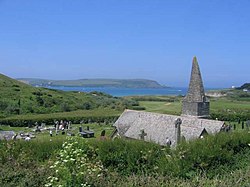St Minver
| St Minver Cornish: Sen Menvra | |
| Cornwall | |
|---|---|
 St Enodoc Church | |
| Location | |
| Grid reference: | SW965771 |
| Location: | 50°33’32"N, 4°52’26"W |
| Data | |
| Population: | 2,393 (2011) |
| Post town: | Wadebridge |
| Postcode: | PL27 |
| Dialling code: | 01208 |
| Local Government | |
| Council: | Cornwall |
| Parliamentary constituency: |
North Cornwall |
St Minver is a village in northern Cornwall, close to the county's north coast, on the road to Rock. The village is centred on a crossroads. The wider parish is nominally divided into St Minver Highlands (to the north and east) and St Minver Lowlands (to the west).
The combined parish is bounded on the south and west by the estuary of the River Camel, on the north by the Atlantic coast, and on the east by the parishes of St Endellion and St Kew.[1] The population of the parish in the 2001 census was 2,474 (St Minver Highlands 1025; St Minver Lowlands 1,449) decreasing to 2,393 at the 2011 census.
Settlements
The principal villages in the combined parish are the churchtown, St Minver itself, and also Rock, Trebetherick and Polzeath. Other hamlets include Tredrizzick, Penmean, Splatt, Porthilly, Pityme and Trevanger.
St Minver village is centred on a small square at the crossroads of two unclassified roads. It is 3 miles north of Wadebridge a few hundred yards west of the B3314 Wadebridge to Delabole road.
There is a holiday park on the southern edge of the village.
Churches
The village of St Minver and its surrounding area is dominated by the tall spire of St Menefreda's church (the parish church) named after St Menwreda (variously St Mynfreda or St Minefreda, the origin of the present day name St Minver) who was one of the 24 children of St Brychan, a Welsh king. In the church is the brass of Roger Opy, 1517.[2]
There are two other churches in the parish, both in St Minver Lowlands.
- St Enodoc church stands between Rock and Trebetherick at SW931772. It was built on towans (coastal sand dunes) in the fifteenth century and gradually became buried by the shifting sands. The church was restored in the 1860s and now stands incongruously in the middle of a golf course. John Betjeman, the former poet laureate is buried in the churchyard.
- St Michael's church stands on the south shore of Porthilly Cove, an inlet of the River Camel just south of Rock, at SW936753. This church was also substantially restored in the 1860s.
Quaker Meeting House and burial grounds
There was formerly a meeting-house in this parish, with a cemetery belonging to the Quakers. The walled Quaker burial ground at SW955778 near Treglines was used between 1665 and 1742 and twenty-eight burials are recorded.[3] The ground contains no headstones - only trees.
A small biographical tract was published in 1709, entitled A Brief Narration of the Life, Service, and Sufferings, of That Faithful Servant of Jesus Christ, John Peters; Who Departed This Life, in the 63d Year of His Age; On the 11th Day of the 7th Month, 1708, and was Buried in Friends Burying-Place at Minver in the County of Cornwall, the 13th of the same. Together with the Testimonies of His relations and other Faithful Friends, concerning his Christian example in the Church of Christ. London: Printed and sold by T. Sowle, in White-Hart Court in Gracious-Street, 1709.[4] This person was steward to the Carew family at Roserrow.[5]
The walls of the burial ground are listed structures.[6]
Outside links
| ("Wikimedia Commons" has material about St Minver) |
- Ecclesiastical parish history
- Cornwall Record Office Online Catalogue for St Minver
- St Minver Lowlands & Highlands Parish Councils
References
- ↑ Sir John Maclean: "Parochial and Family History of the Parish of St. Menefreda"; p. 4, 1876
- ↑ Dunkin, E. (1882) Monumental Brasses. London: Spottiswoode
- ↑ Kelly's Directory 1939 Description of St Minver, Cornwall P238 to 240
- ↑ Copies in Friends House Library and Cornwall Quaker Library
- ↑ Daniel Lysons & Samuel Lysons {{brithist|50647 'Parishes: Mevagissey - Mullion', Magna Britannia: volume 3: Cornwall (1814), pp. 227-244.] Date accessed: 16 October 2009.
- ↑ National Heritage List 1211540: St Minver